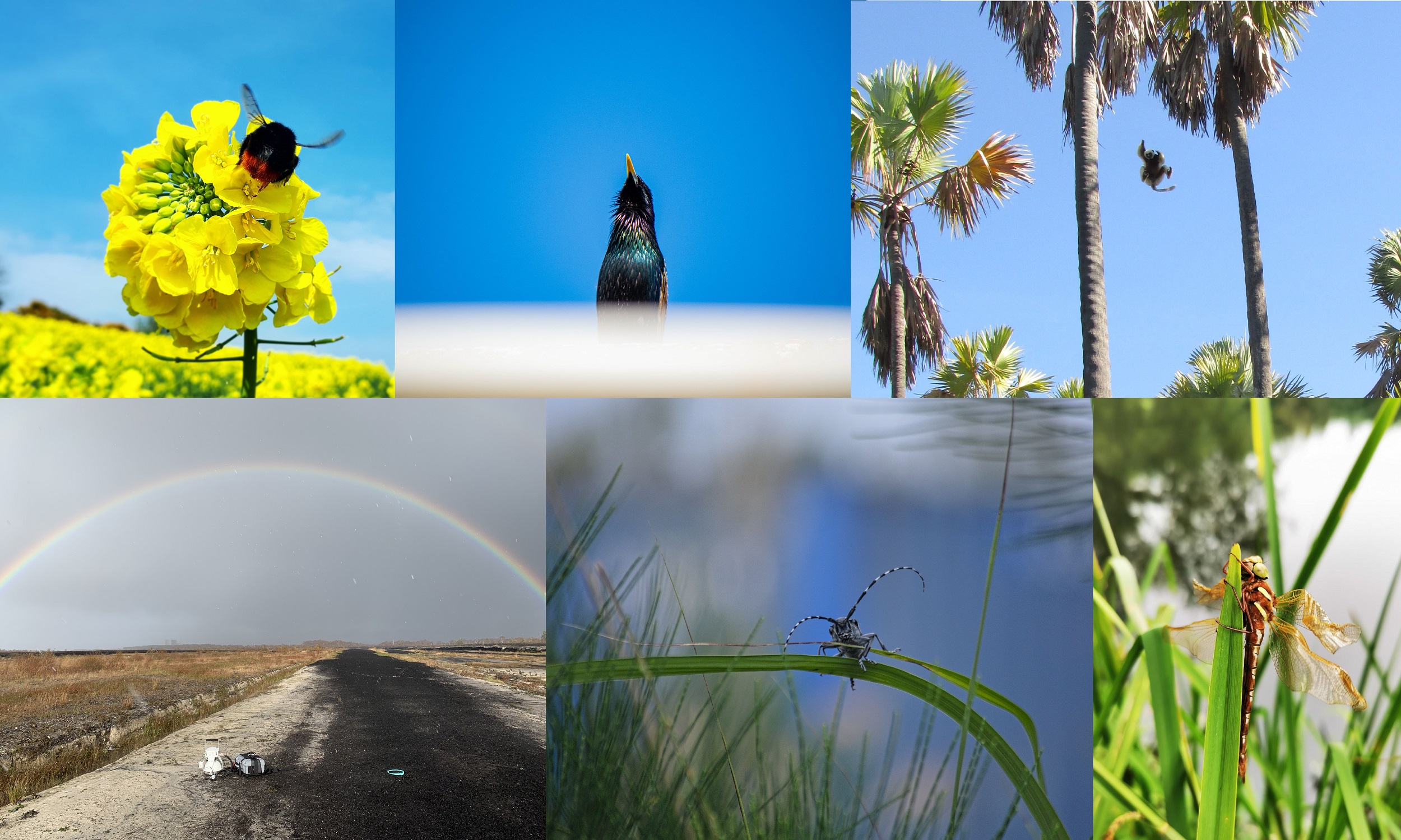Drumroll please! It’s the moment we’ve all been waiting for! The votes have been cast, they’ve been counted and recounted, and we can finally showcase the entries and reveal the winner of the 4th EcoEvo blog photo competition!
Last year saw some fantastic entries to the competition, but this year has raised the bar (in our humble, very biased opinion). It seems the pandemic won’t keep good photographers down! We would like to thank everyone who took part in the competition by contributing their fantastic shots – it really was a pleasure to see them all. We’d also like to thank everyone who voted on the finalists and, of course, our special guest judge John Holden for making the difficult decisions and selecting just 5 finalists from over 30 entries. John was also kind enough to give us an interview about his work, which if you haven’t seen yet we highly recommend. To see why we asked John to be our judge, check him out on Facebook (@WildAboutWexford) or follow him on Twitter (@wildaboutIRL) for unparalleled examples of Irish wildlife photography.
Before we reveal the finalists and the winner, let’s take a tour through the gallery of entries for the 2020 competition:
The Entries
ELENA ZIOGA
Elena Zioga is a PhD student in Prof. Jane Stout’s lab. She is evaluating the potential for pesticide contamination of floral resources as a result of translocation from the soil.
Free elegance

‘Free elegance’ shows the butterfly species Aricia agestis feeding on a wild onion growing in the middle of a wheat field in Greece
Trapped beauty

‘Trapped beauty’ shows the cinnabar moth Tyria jacobaeae, temporarily trapped in a plastic vial during a bean field inspection in Ireland.
JAMES ORR
James Orr is a PhD student in Dr Andrew Jackson’s lab. He uses theoretical and empirical approaches (mesocosms) to understand the impacts of multiple stressors at the higher levels of biological organisation (communities, ecosystems).

A long-exposure photograph of the Milky Way stretching over the ExStream system. This was taken during our six week field experiment in New Zealand where we tested the effects of multiple stressors on freshwater food webs.
IRENE BOTTERO
Irene Bottero is a PhD Student in Prof. Jane Stout’s lab. s investigating the impacts of different threats on pollinators around Europe, in order to model a risk assessment for bee health.
Red Flash
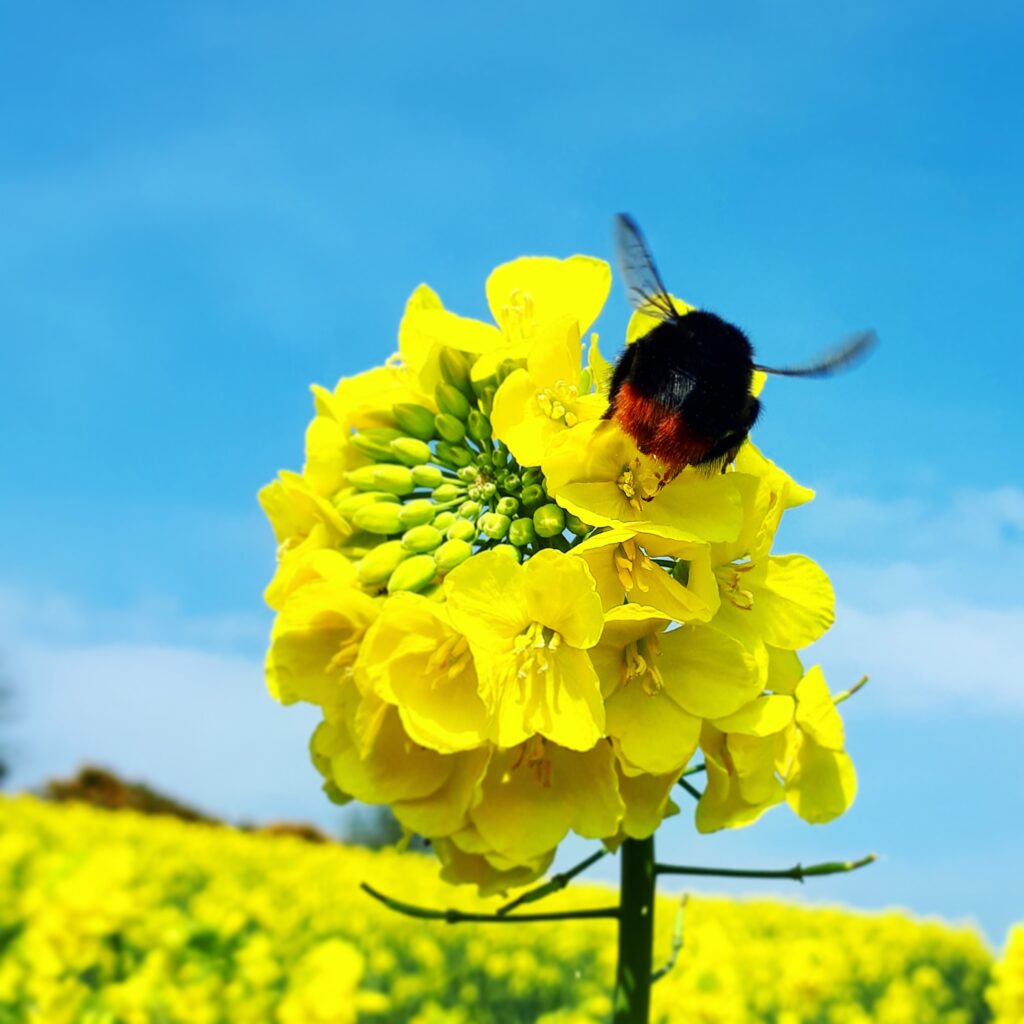
I was taking a break during my field work when a flash of red suddenly caught my attention. It was buzzing past at speed and its contrast against the yellow and blue background made it seem like it was shimmering. I came to realise it was the fluffy butt of a red-tailed bumblebee. Apparently, we were both taking a break from our tough work – the bumblebee, resting on an oilseed rape flower and me, admiring its hairy and shiny body.
Not that Liath*
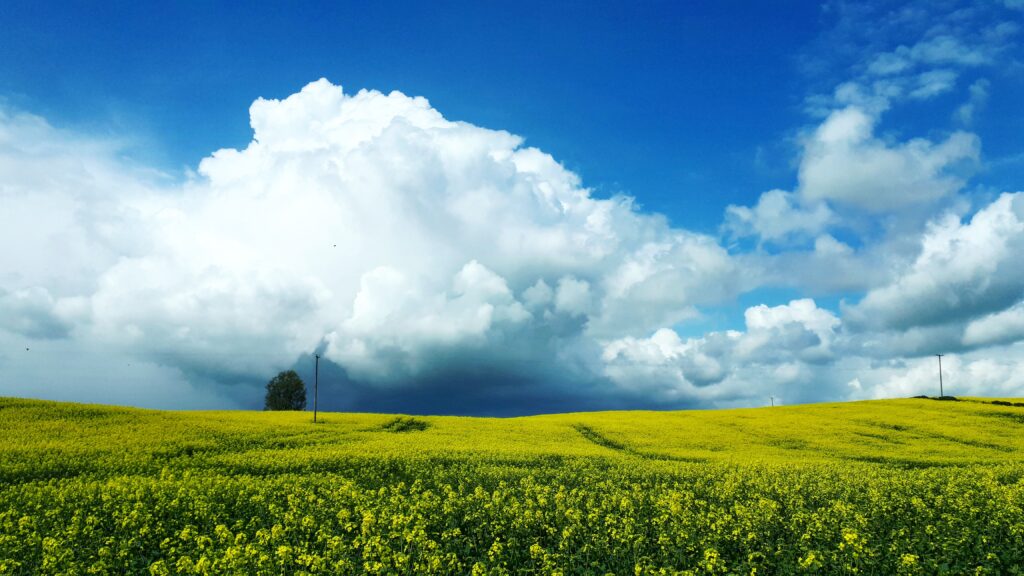
On this day it was pouring rain and I was sitting in the van wondering if it was a good idea to be out in the field or if I should pack up and go back home – my job couldn’t be performed in those weather conditions. Suddenly, the wind blew away the clouds and the grey scenario in front of my eyes turned into the most incredible view. I found this to also be representative of my entire field season since a lot of the time it was tough, terrible and grey, but whenever I was very close to calling it a day, I would always be surprised by something which would give me great joy.
* From Old Irish líath: Grey
SAMUEL ROSS
Samuel Ross is a PhD student in Dr Ian Donohue’s lab. He aims to broadly assess the impact of different aspects of global change on multidimensional ecological stability, using two complementary study systems in Japan.
Perseverance

A Long-Horned Beetle (Cerambycidae sp.) struggles to climb over a particularly troublesome blade of grass. A blue shipping container behind this tiny feat of perseverance reminds us of the sheer scale at which we’re changing our environment. This beetle could represent any one of us in the many struggles we’ve faced this year.
Not-so-green infrastructure
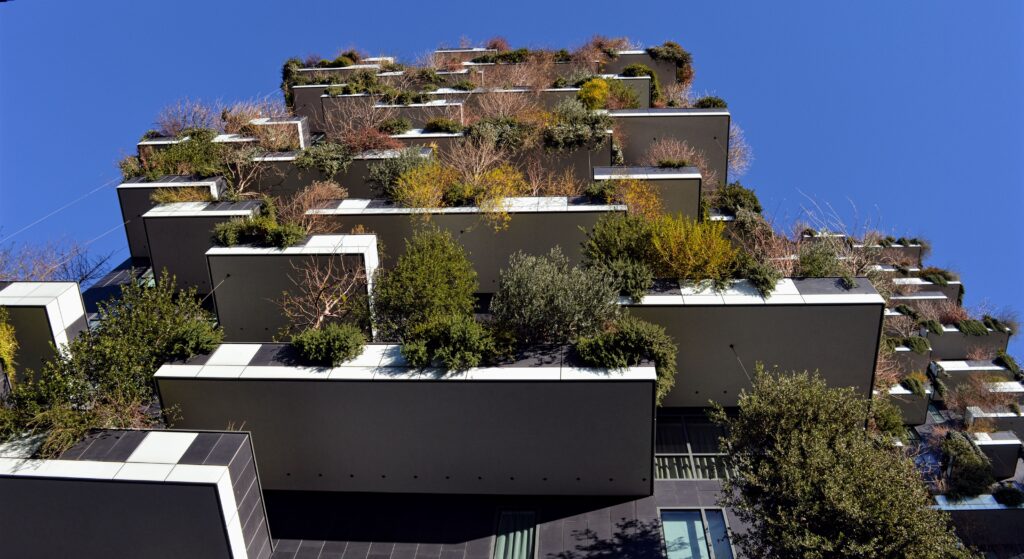
Green infrastructure doesn’t always live up to its name. Here, Bosco Verticale (literally, ‘vertical forest’) stands on a cold but clear January day in Milan. During the winter months many of the beautiful vines, shrubs, and trees drop their leaves and present a less aesthetically pleasing attempt at urban greening. Whether these joint architectural-ecological projects will prove to be nature-based solutions in the long run depends on how well they can support nature’s contributions to people year-round, not only in the photogenic summer months.
JENNY BORTOLUZZI
Jenny Bortoluzzi is a PhD student in Dr Andrew Jackson’s lab. She studies the spatial and foraging ecology of marine predators with a particular focus, and passion, for sharks and their relatives.
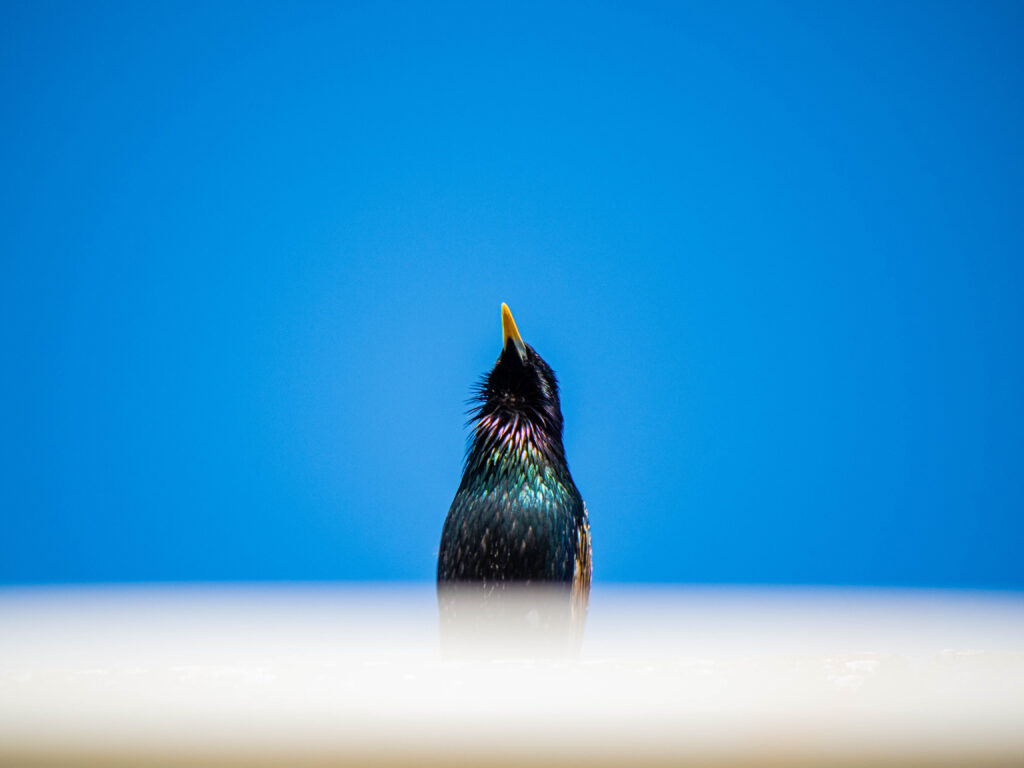
A starling singing from the roof captured during our early months of isolation. My world was restricted to one room and the garden I shared with my landlords. As I tried to make the most of the latter, I got to know a couple of starlings as they visited the garden daily to find food. My favourite part of their visits was the colour display when the sunlight caught their feathers. I’m normally a marine ecologist, but by observing their behaviours in the garden made a terrestrial ecologist out of me for a little while!
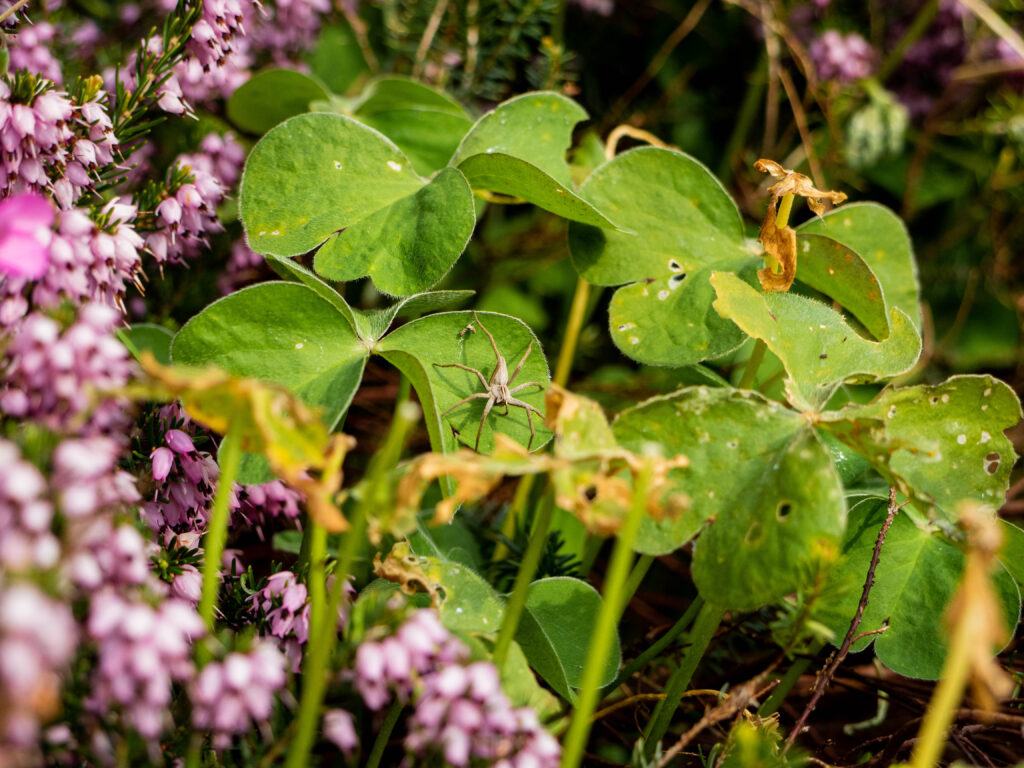
Who would have thought I, the biggest arachnophobe around, would offer up a photo of a spider for this photo competition! I took this photo in May during isolation (again), when I really made time (not that I had to try hard… time was aplenty!) to observe the macro-world around me. This is a male nursery web spider, Pisaura mirabilis, (thanks to Collie for the ID) stealthily hiding among the Irish heath and, what I believe to be, pink-sorrel leaves. Does this make me an arachnophobic arachnologist now?
JEAN WILLIAMS
Jean Williams is a PhD student in Dr Marcus Collier. She aims to examine if wild edibles can transition towards a more sustainable food system.
Dancing on the Dooder
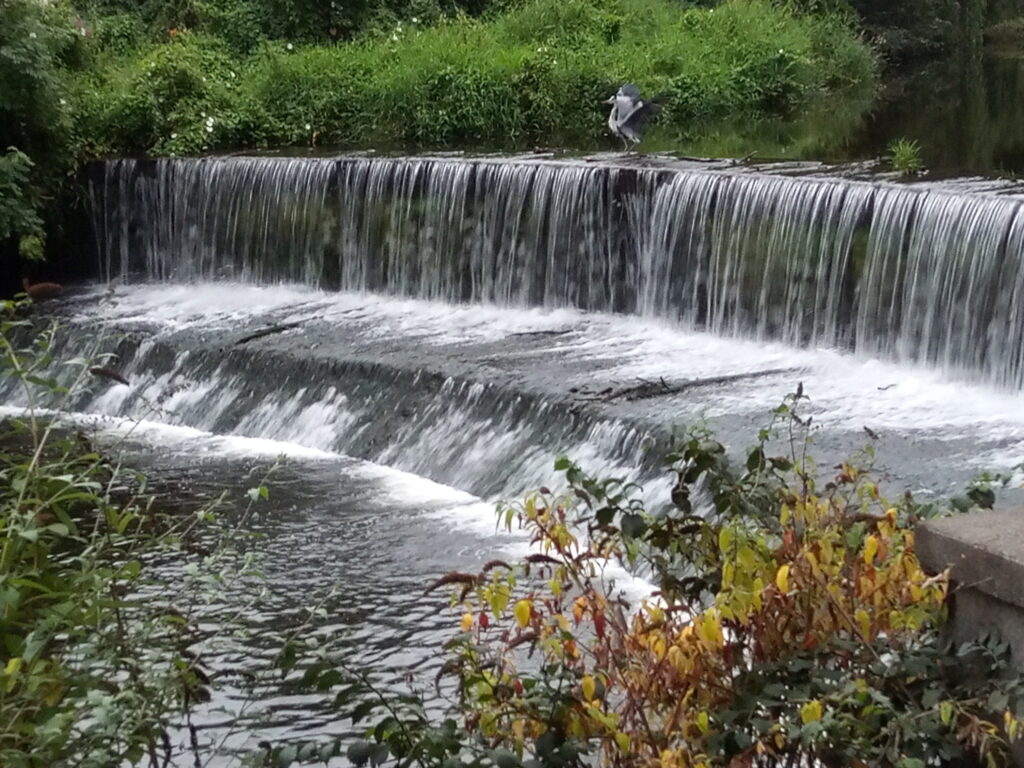
This photo of a heron dancing and twirling on the top of a waterfall was taken on the Dodder walk, in Dartry, this August.
PAULA TIERNEY
Paula Tierney is a parasite ecologist and a PhD student in the Holland Parasitology Lab. She studies how biological invasions affect helminth worm communities in native and invasive species using a freshwater fish model system.
Rainbow ecology
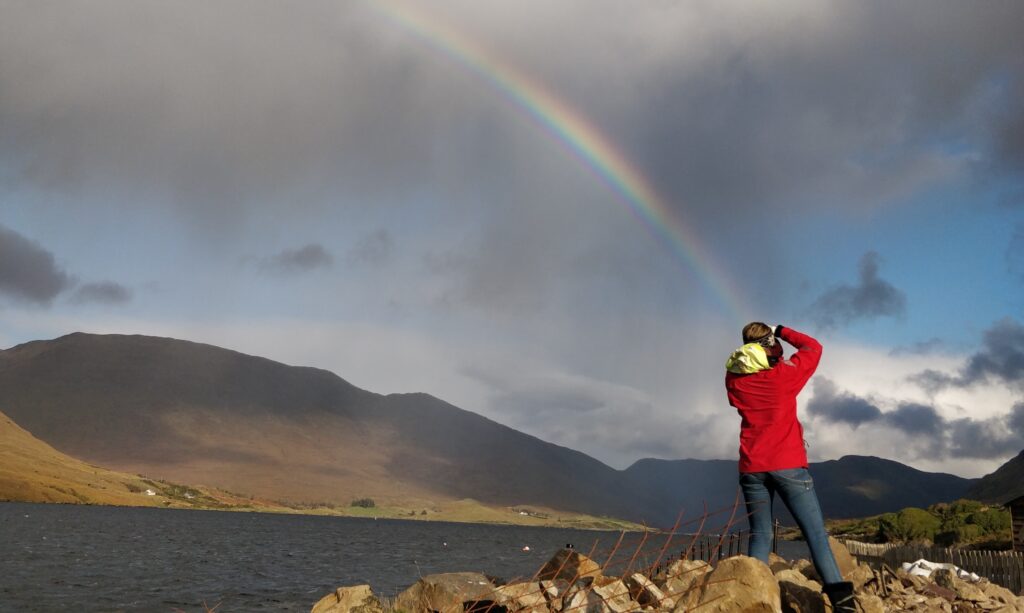
Mystery member of TCD Zoology is photographed photographing a rainbow at Killary Fjord.
Good morning
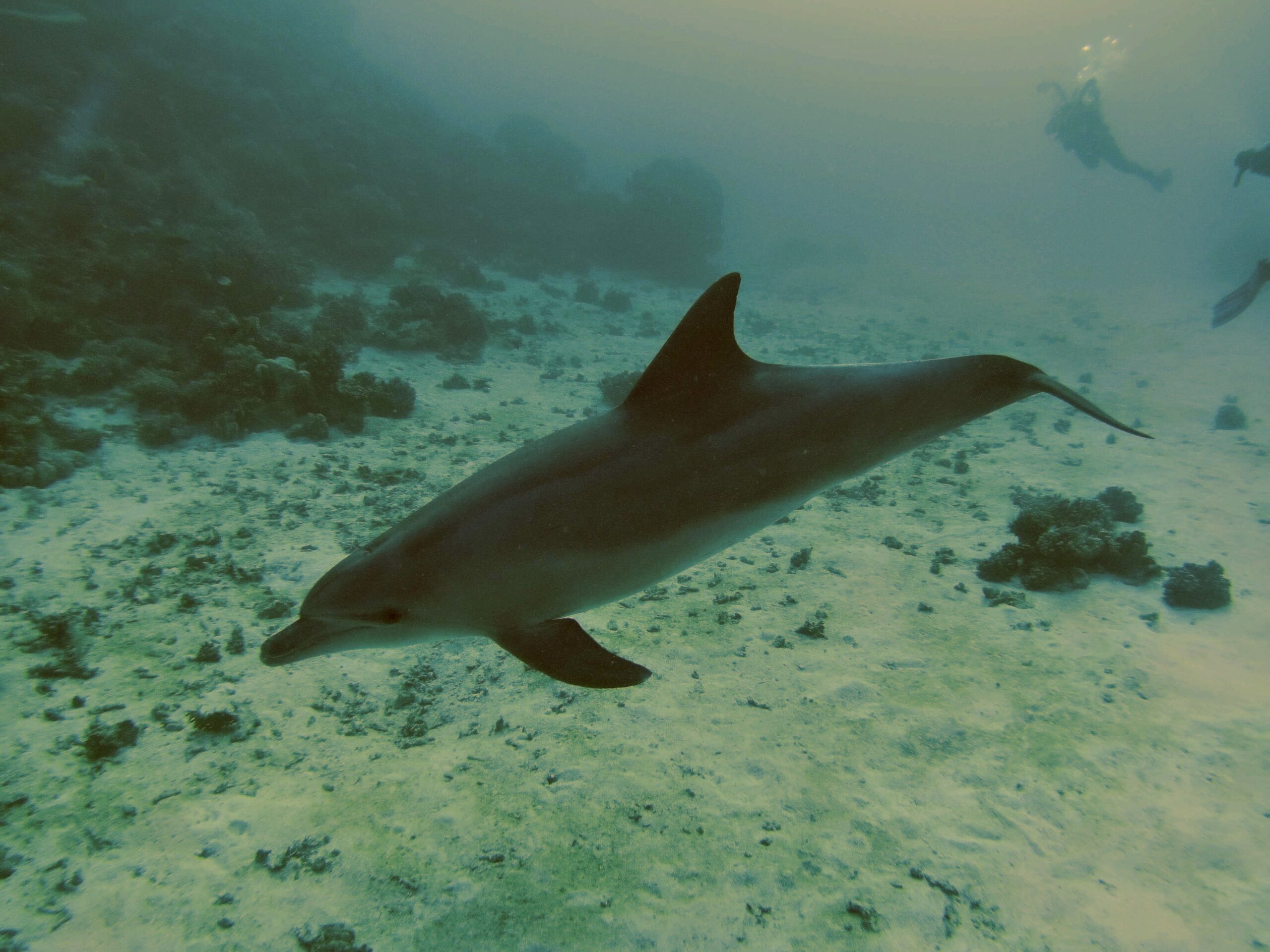
6am, 12 metres down in the Red Sea: dolphins congregate to clean themselves on the coral of Sha’ab Samadai reef, as seen on Blue Planet II and Paula’s knock-off budget GoPro.
MAUDE BAUDRAZ
Maude Baudraz is a PhD student. She focuses on demographic processes and how they link to the position of populations within a species niche.

Description by the editors: The Alps make a stunning backdrop against which to conduct ecological research!

Description by the editors: A fire salamander making his way around on a wet night. The striking yellow and black pattern warns potential predators that he is toxic.
FIONN Ó MARCAIGH
Fionn Ó Marcaigh is a PhD student in the Marples’s lab in the Department of Zoology, studying speciation and biogeography
Stranded
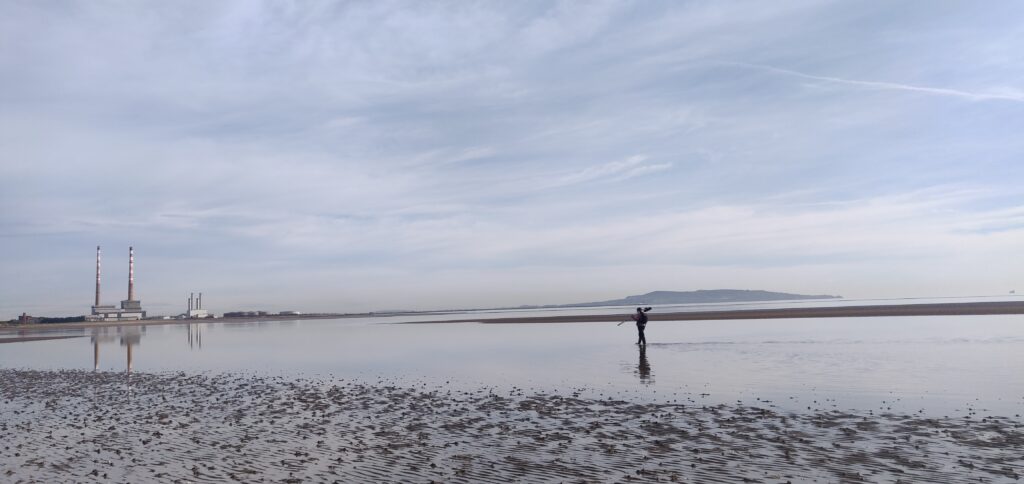
A resolute birder takes part in the Irish Wetland Bird Survey on Sandymount Strand, a landscape where sand, sea and sky merge in steely blues. Every month between September and March, IWeBS participants flock to waterways around Ireland to gather data on the birds wintering in Ireland or migrating along the East Atlantic Flyway. The 2019 report, available on the NPWS website, showed substantial declines in many species.
The Leap
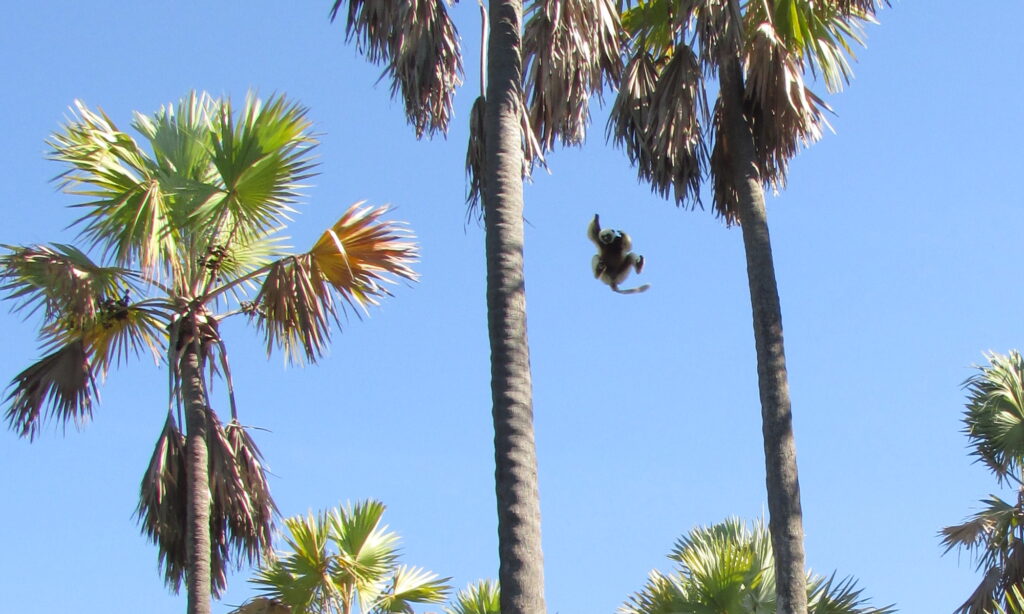
Caught in the moment as if suspended, a Coquerel’s Sifaka (Propithecus coquereli) leaps between trees in Ankobohobo Wetland on the northwestern coast of Madagascar. As well as these magnificent lemurs, Ankobohobo’s mangrove is an important habitat for many bird species. Ó Marcaigh et al (2020) gave the first description of this rich bird life, while noting that its future hangs in the balance as conservation pressures mount.
JANE STOUT
Jane Stout is a professor in the Botany Department. She is an internationally renowned expert on pollinator and pollination ecology, and a prominent voice for biodiversity and its value.
Lockdown life…
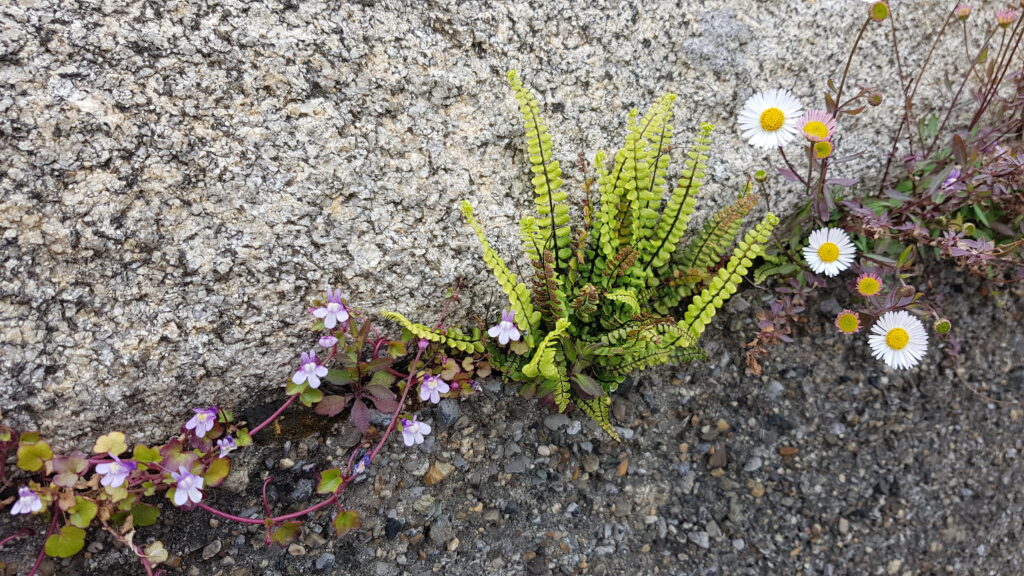
Lockdown life: as our worlds constricted in 2020, here’s some small-scale biodiversity from an urban wall…
RUCHITA INGLE
Ruchita Ingle is a PhD student in Dr Matthew Saunders’s lab.
Ray of Hope
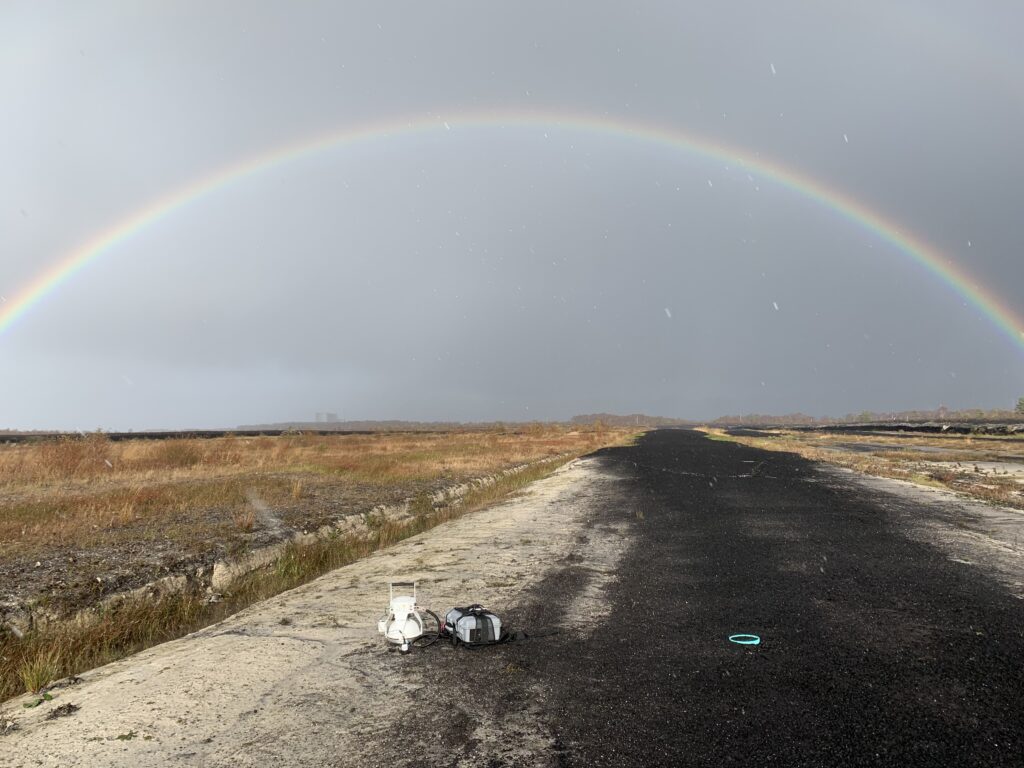
This picture was taken on 28th October 2020 at a former industrial peat extraction site where they have stopped peat extraction since a couple of years and is ready to go under the process of rehabilitation. The vegetation in the picture shows peatland’s adaptive capacity to get back to its natural state. I am measuring the carbon and greenhouse emissions between soil and atmosphere using the state-of-the-art technology of the smart chamber and trace gas analyser as shown in the picture. The title was selected based on how a rainbow appeared in the middle of a hailstorm (visible in the picture after zoom) that day.
Going on an adventure……
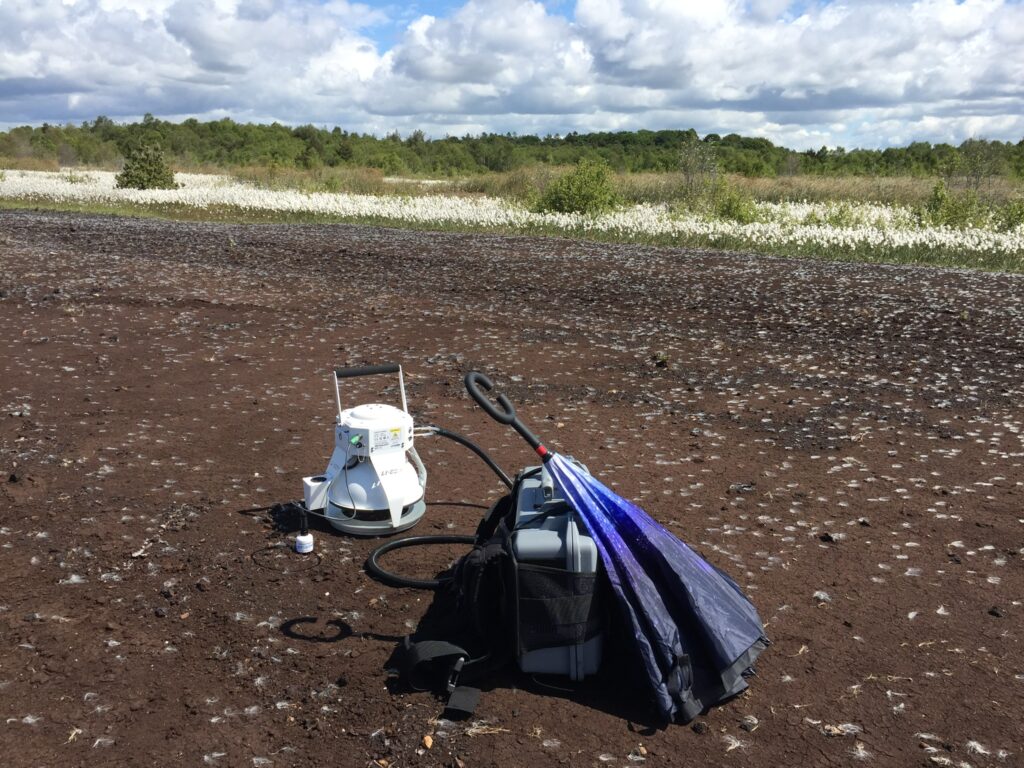
This picture was clicked on 5th June 2020 at a cutaway bog (Lullymore, Co. Offaly) which went under rehabilitation more than a decade ago. A whole spectrum of various stages of rehabilitation can be seen in this picture starting from bare peat, shrubs, and bog cotton (Eriophorum angustifolium) to a dense Birch forest mosaic. The trace gas analyser (suitcase) and smart chamber used to measure carbon and greenhouse gases are also visible in the picture. An umbrella is extremely important while going on an adventure to these bogs even during the summertime. So, it’s crucial to include it in the picture. The title is inspired by a book “The Hobbit” as it is like going on an adventure every time I go for fieldwork with a suitcase, an umbrella, rain gear, and a smart chamber that looks like a huge lunch box. I truly feel like Bilbo Baggins.
AOIBHEANN GAUGHRAN
Aoibheann Gaughran is a postdoctoral research and teaching fellow in the Behavioural and Evolutionary Ecology Research Group. She is currently working with Prof Jane Stout as Project Manager and Mammal Ecologist on the Áras an Uachtaráin Biodiversity Audit.
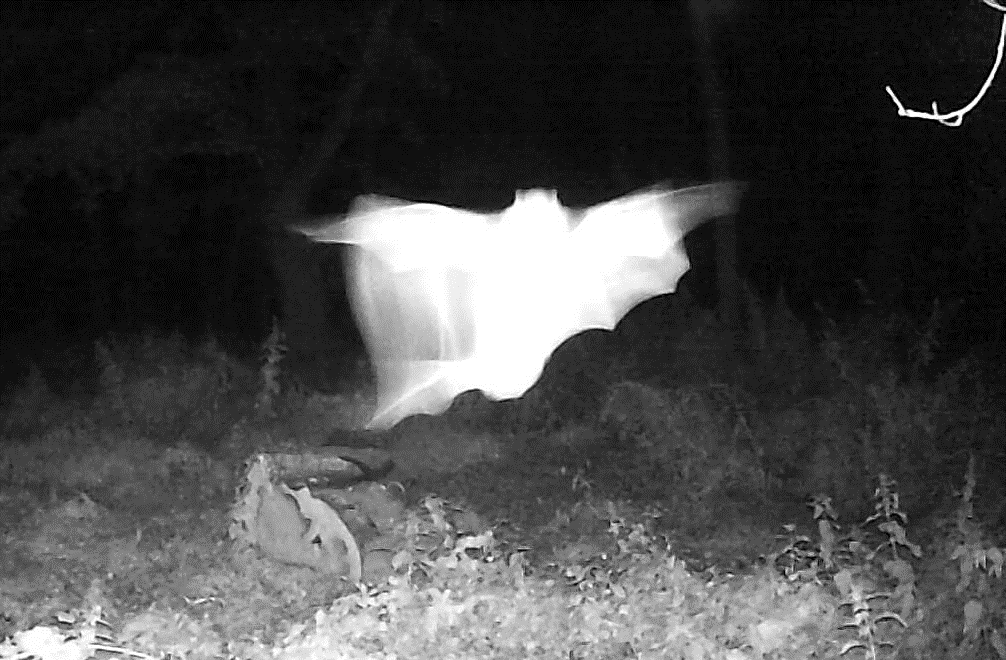
Bat (sp. unknown) using infra-red light from a trail camera to hunt moths – taken during Biodiversity Audit of Áras an Uachtaráin.
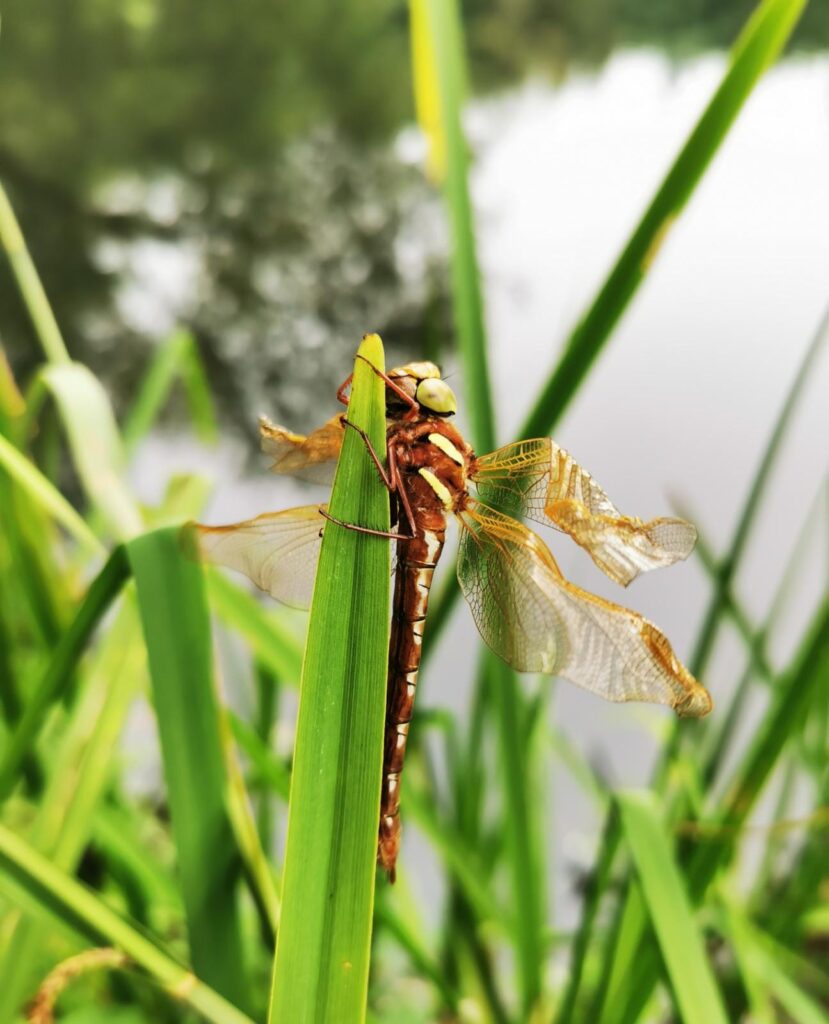
Brown hawker dragonfly destined never to fly – taken during Biodiversity Audit of Áras an Uachtaráin.
MARINE VALMIER
Marine Valmier is a PhD student in Dr Matthew Sanders’s lab. She is studying the impacts of hydrology on the greenhouse gas (GHG) emissions from grassland on drained organic soils, in order to assess the mitigation potential of water table management.
Dragon-cotton
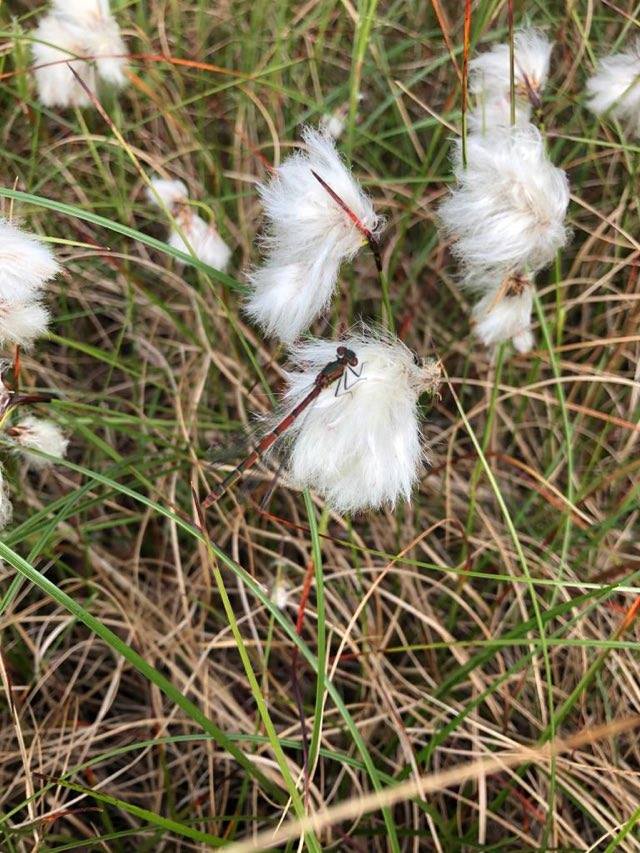
Peatlands are not only an equivalent to an underground rainforest in terms of carbon storage, they’re also a beautiful and unique ecosystem in terms of biodiversity. It is notably a heaven for dragonflies, and transforms to a snowy-like white paradise, right in the middle of the warmest month, when the very typical bog cotton appears. I took this picture on the first day we were able to go back to fieldwork after the first lockdown, so it is also a nice memory.
Irish luck
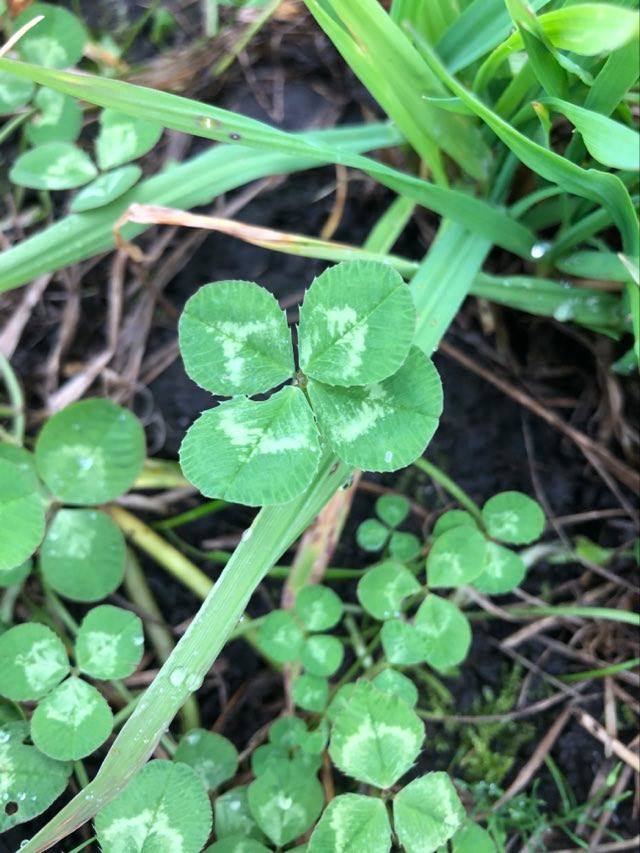
I took this picture while catching my breath after carrying heavy equipment across the grassland that I monitored to assess its GHG emission. I dropped my gaze and it was there, it felt like it was waiting for me, and that nature was rewarding me for always keeping a eyes out to let myself be surprised by its wonders. I’d like to share that feeling with you all through this picture, in addition to some Irish good luck and good vibes.
ERIKA SOLDI
Erika Soldi is a research assistant in Prof. Trevor Hodkinson’s lab. She is currently working on ash dieback disease in Ireland.
Botany Department entrance in spring
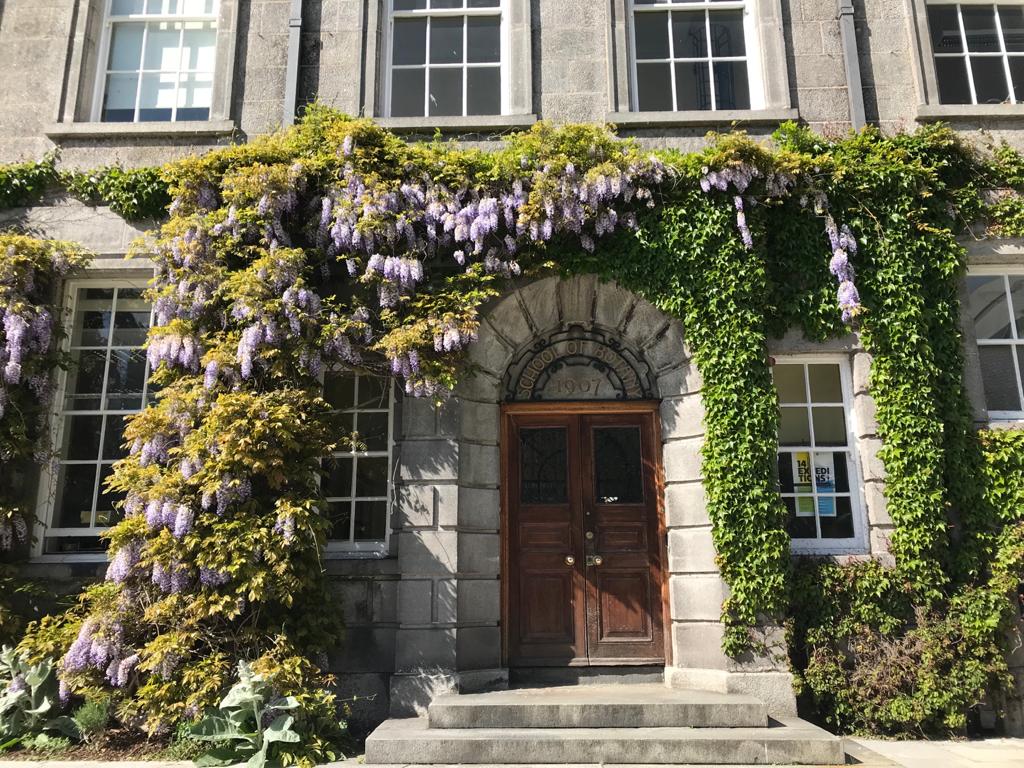
The Botany Building is that magical and historical place where for more than a hundred years, precisely 113, plants have been studied, categorized and carefully kept safe in the Herbarium. I feel very humble and gifted to enter through this door every morning. This entrance changes based on the season: the leaves turn to an intense red fire to remind you that “summer” is over; the empty shoots tell you that is that moment of the year when you should remain cosy on your sofa drinking wine or a hot chocolate; a powerful splash of green yells that spring is finally here; then these marvellous violet flowers bloom (Wisteria sp.) that once again makes you reflect on how beautiful nature is and how gifted we are!!!
Colourful Howth Summit
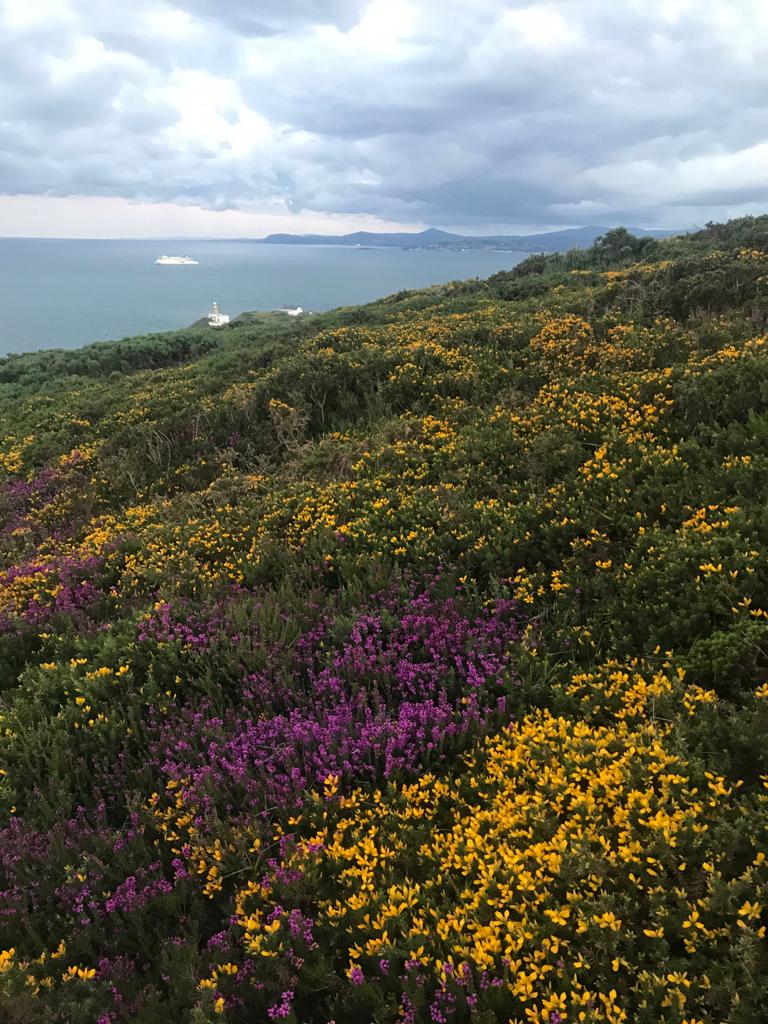
During summer the hillside of Howth Summit sparks of purple and yellow colours in contrast with the grey and blue of the hovering clouds and untamed sea. The yellow is originated by Ulex galii (known also as western gorse or dwarf furze) which is a spiky evergreen shrub in the pea family. Meanwhile, the purple is originated by Erica cinerea (or bell heather), a flowering plant from the Ericaceae family, with which I share the same name.
SAMUEL PRESTON
Samuel Preston is a PhD student in the Marples’s lab. He is studying animal behaviour and dietary conservatism.
Charles Testudinidae
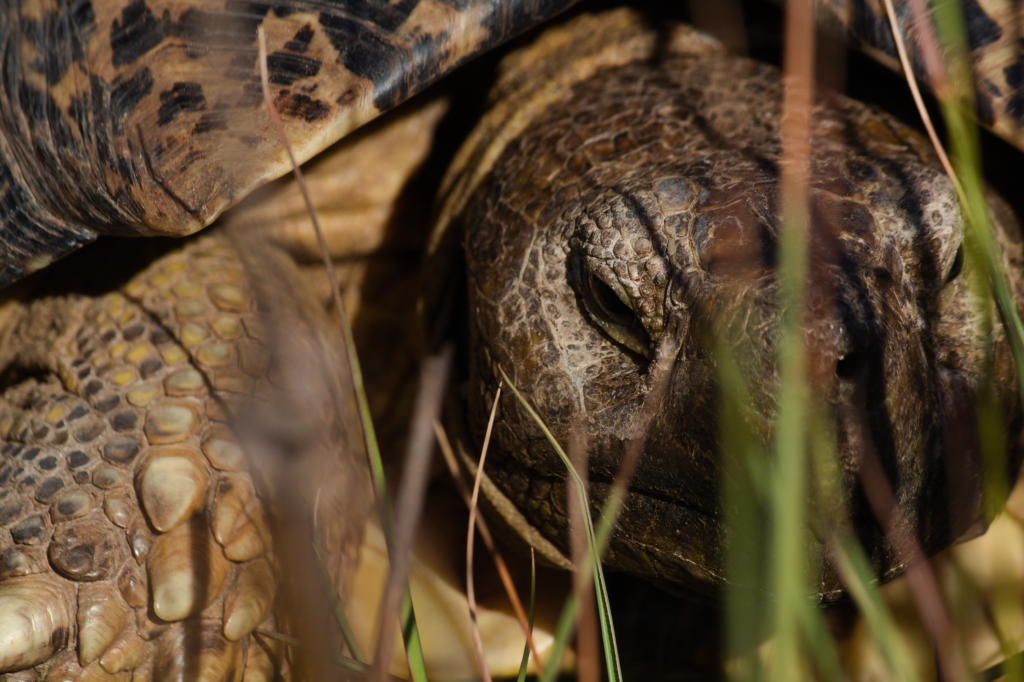
I took this photo on a field course in South Africa. I’ve always had a soft spot for tortoises and Charles (a name that just seemed to fit) was very obliging, not at all put out by everyone on the course crowding him. This year, a lot of fieldwork (especially overseas) has been cancelled or curtailed due to the pandemic, which is frustrating for researchers and a real pity for students. It’s not just about the lost learning – it’s also missed opportunities to connect with nature and develop your passion for understanding and preserving it. And meeting personalities like Charles, of course.
Finalists
As we move into the finalists’ wing of the gallery, each photo is accompanied by a note from our judge explaining why this image captured his imagination.
FLORIANE O’KEEFFE
Floriane O’Keeffe is a PhD student in Dr Pepjin Luick’s lab. Her research focuses on the effects of warming and parasitism on aquatic invertebrates.
Breaking the Surface

A humpback whale breaches off the coast of Puerto Lopez, Ecuador. During the summer months, this area serves as a breeding ground for these majestic creatures. After seeing several breaches from a distance, this whale breached only metres from our boat, giving me the opportunity to capture this moment.
JUDGE, JOHN HOLDEN: One word: Envy. I really wish I had taken this shot. I know how many balls had to be in the air to capture this wonderful moment.
KATRIN SCHERTENLEIB
Katrine Schertenleib is a PhD student in The O’Connor Lab. She aims at quantifying the impact of multiple stressors on the production of marine benthic resources.
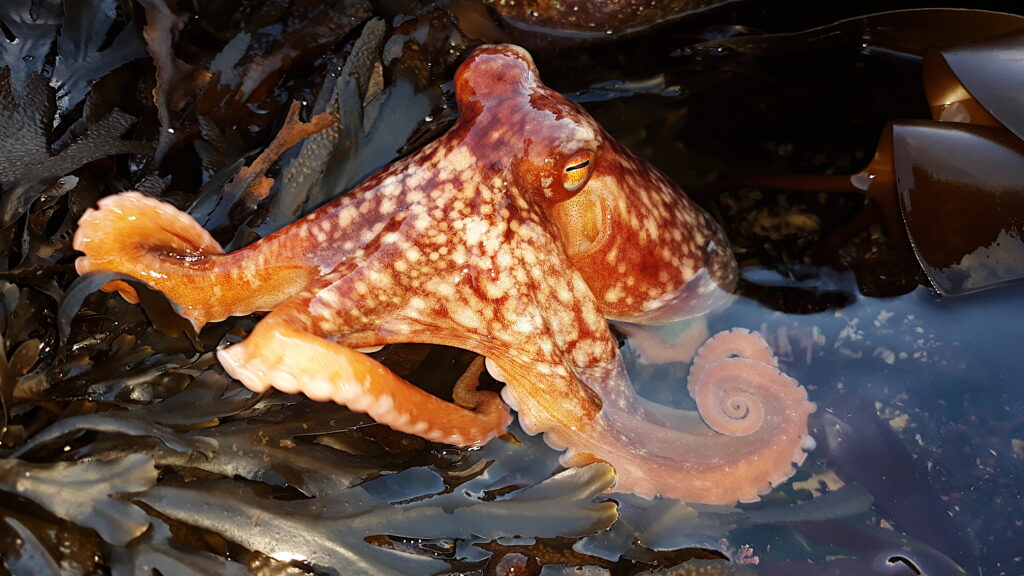
A curled octopus (Eledone cirrhosa) explores the neighbourhood while trapped in rock pools during low tide at an Irish rocky shore.
JUDGE, JOHN HOLDEN: Just a simple reportage that manages to capture so much colour and texture, the underwater tentacles bring the shot to life.
DAVID J. KELLY
David Kelly is a Research Fello in Marples’s lab. He is currently investigating uptake rates of candidate oral vaccine baits (for TB) by badgers.
Hop-On-Hop-Off

The blue poison dart frog (Dendrobates tinctorius azureus) is found in the forests of Suriname and Brazil. While frequently considered a valid species in the past, recent genetic studies suggest it is a subspecies of the dyeing poison dart frog (Dendrobates tinctorius). Poison dart frogs rely on a signalling system called aposematism (an overt signalling of danger or unprofitability). These frogs acquire their toxins from a specialized diet of ants, millipedes and mites. These arthropods sequester toxins from rainforest fungi and plants. However, as the toxins are a result of rainforest food webs, captive-bred poison dart frogs lack them. Consequently, captive-bred poison dart frogs should be a little more circumspect in their behaviour, especially as the Emerald Tree-boa (also pictured) is known to feed on lizards and frogs!
JUDGE, JOHN HOLDEN: One of those great shots that presents more questions than answers…
Blue skies thinking

The Blue-headed Tree Agama (now known as the Black-necked Agama – Acanthocercus atricollis) is an African lizard that is adapted to live in trees. Like leopards, they are ambush predators, and spend a lot of time inactive. They feed on arthropods in trees. While there is always a steady supply of ants, they are happy to eat grasshoppers, beetles and even millipedes. Males tend to have larger and more brightly coloured heads than females. These ornaments serve as indications of the quality of males (like the tails of peacocks, or the antlers of deer) and are used to signal other males when territorial disputes arise. Generally, this signalling helps to avoid combat, as only animals with similarly matched ornaments are seen to fight.
JUDGE, JOHN HOLDEN: This is all about the composition, it’s very simple but effective – the blue background has a lovely relationship with the subject.
Finally, at the end of the finalists’ wing and in its own, soft lit display – the pride of the Marvelous Photo Competition 2020 gallery and voters’ favourite:
Winner
FLIGHT IN LAVENDER

A male Rufous-tailed hummingbird in flight in Mindo, Ecuador. Hummingbirds are the only birds that can fly backwards, and are some of the smallest birds in the world.
JUDGE, JOHN HOLDEN: Very impressive shot – I can only imagine it’s like trying to bottle lightning capturing one of these in mid hover.
Congratulations, Florianne! It’s a beautiful shot and we’re delighted to make it the banner for the EcoEvo blog!

